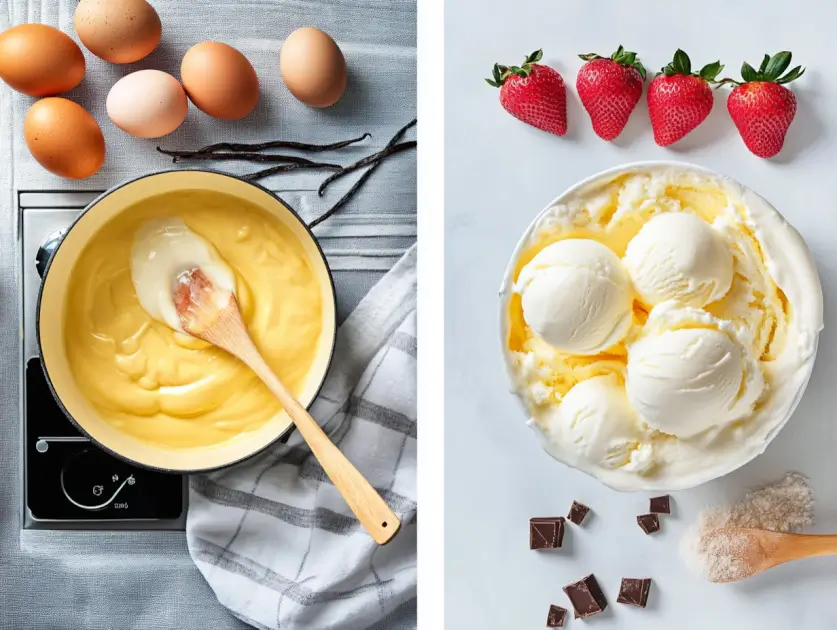Introduction
How to make custard vs ice cream? Dessert enthusiasts have puzzled over this question for years. Both treats offer creamy textures, but their flavor, texture, and preparation methods differ significantly. Custard delivers smoothness and richness, while ice cream provides a light and frosty experience. Each dessert brings unique qualities to the table, making it important to grasp their distinctions. This article will help you understand the key aspects of how to make custard vs ice cream, equipping you with the knowledge to create these delightful sweets confidently. Throughout, you’ll learn about their characteristics, preparation methods, and creative variations.
Table of Contents
What is Custard?
Custard, at its core, is a dessert made from a combination of milk or cream, eggs, and sugar. It is thickened primarily by egg yolks, giving it a velvety texture. Answering how to make custard vs ice cream involves understanding custard’s defining feature: its reliance on gentle heat to achieve the perfect consistency.
Custard can be classified into different types—stirred custard, which is cooked on the stovetop, and baked custard, like crème brûlée. Popular worldwide, custard often serves as a standalone dessert or as a component in layered dishes. Its versatility makes it ideal for experimenting with flavors like vanilla, coffee, or chocolate. To master custard, remember patience is key. The slow cooking process prevents curdling and ensures the result is smooth and luscious.
What is Ice Cream?
Ice cream, a frozen dessert beloved by all, is created by churning a mixture of cream, milk, sugar, and flavorings. A defining aspect of how to make custard vs ice cream lies in the air incorporated during churning, which gives ice cream its light, fluffy texture. Ice cream has a long history, dating back centuries, and its evolution has led to countless flavor variations. From classic vanilla to exotic combinations like matcha or lavender, the options are endless.
Unlike custard, ice cream often omits eggs, though some recipes include them for a richer texture. Modern techniques allow for dairy-free and vegan alternatives, expanding its appeal. Understanding the science behind freezing is essential for achieving a smooth consistency and avoiding the dreaded icy texture.
Key Differences Between Custard and Ice Cream

When examining how to make custard vs ice cream, their differences become clear in texture, flavor, and preparation. Custard has a denser and creamier texture, owing to its high egg content. Ice cream, on the other hand, is airier due to the churning process. Additionally, custard is cooked on a stovetop, while ice cream requires freezing during its preparation. The differences in ingredients are equally notable. Custard uses egg yolks as a thickening agent, while ice cream relies on cream and sugar as its primary components. Nutritional profiles also vary, with custard generally containing more fat due to its egg content. Both desserts offer unique flavor profiles, and choosing between them often depends on personal preference or the occasion.
How to Make Custard
To master how to make custard vs ice cream, understanding custard’s preparation is crucial. Follow these steps to create the perfect custard:
- Ingredients: Gather milk or cream, egg yolks, sugar, and vanilla extract.
- Step 1: Heat milk and sugar in a saucepan until warm but not boiling.
- Step 2: Whisk egg yolks in a separate bowl.
- Step 3: Gradually add the warm milk to the yolks, whisking continuously.
- Step 4: Return the mixture to the stove and cook on low heat, stirring until thickened.
- Step 5: Strain through a sieve to remove lumps, then cool before serving.
Avoid overheating to prevent curdling, and always use a heavy-bottomed pan for even cooking.
How to Make Ice Cream
The process of how to make custard vs ice cream highlights ice cream’s reliance on freezing and churning. To create a delicious ice cream, follow these steps:
- Ingredients: Combine heavy cream, milk, sugar, and your choice of flavorings.
- Step 1: Mix the ingredients until the sugar dissolves.
- Step 2: Pour the mixture into an ice cream maker and churn according to the manufacturer’s instructions.
- Step 3: Transfer to a container and freeze for a few hours for a firmer texture.
For the best results, avoid overloading with mix-ins, as this can interfere with the freezing process. Proper churning ensures the ice cream’s smooth consistency.
Custard vs Ice Cream: Preparation Techniques
In understanding how to make custard vs ice cream, preparation techniques are a defining factor. Custard requires gentle cooking and constant stirring to prevent lumps, while ice cream demands consistent churning to incorporate air. Both methods require precision and attention to detail to achieve their respective textures. Custard relies on the coagulation of egg proteins, while ice cream depends on freezing at the right temperature to form small ice crystals. Tools like a whisk and a saucepan are essential for custard, while ice cream calls for an ice cream maker or an alternative freezing method, like stirring manually every 30 minutes.
Flavor Variations: Custard and Ice Cream
When exploring how to make custard vs ice cream, flavor variations offer endless possibilities. For custard, consider these creative ideas:
- Add cinnamon or nutmeg for warmth.
- Incorporate citrus zest for a tangy twist.
- Experiment with coffee or matcha for bold flavors.
For ice cream, these popular options are worth trying:
- Mix in fresh fruits or purées for a refreshing taste.
- Combine chocolate chips, nuts, or cookie crumbles for texture.
- Try unusual flavors like lavender, basil, or caramel swirls.
The versatility of both desserts allows for customization, catering to any palate or occasion.
Serving Suggestions
When you think about how to make custard vs ice cream, presenting them well becomes just as important as preparing them. Custard delivers richness and smoothness that pair beautifully with fresh fruits like berries or sliced bananas. You can also use it as a filling for pastries, layer it in trifles, or top it with caramel sauce for an extra indulgence.
Ice cream works wonderfully on its own in a cone or bowl but becomes even better with creative toppings. Add crushed nuts, drizzle chocolate syrup, or top it with whipped cream for a more dynamic dessert. You can also use ice cream in sundaes, milkshakes, or cookie sandwiches. For a refined touch, serve warm custard with a sprinkle of nutmeg or accompany ice cream with a slice of pie or cake. These versatile desserts can adapt perfectly to any occasion or mood.
Custard vs Ice Cream: Dietary Considerations
Understanding how to make custard vs ice cream means considering dietary preferences and restrictions. You can create dairy-free custard by using almond or oat milk and thickening it with cornstarch instead of eggs for a vegan alternative. Similarly, ice cream recipes can adapt to various needs with non-dairy bases like coconut cream or cashew milk.
For those reducing sugar intake, both desserts can be sweetened with alternatives such as stevia or agave syrup. Low-fat versions are also possible by substituting cream with skim milk or yogurt. It’s important to address allergens as well; custard’s egg content might be problematic, but egg-free recipes are readily available. For ice cream, lactose-free options can replace traditional cream for those with sensitivities. These modifications allow everyone to enjoy their favorite dessert without sacrificing flavor or texture.
Storage Tips for Custard and Ice Cream
Proper storage is essential when mastering how to make custard vs ice cream to preserve their quality. Custard should be cooled completely before refrigeration to avoid condensation forming on its surface. Store it in an airtight container for up to three days to maintain freshness. To prevent a skin from forming, cover the surface with plastic wrap before sealing the container.
Ice cream requires airtight storage in the freezer to prevent ice crystals from forming, which can ruin its creamy texture. Placing parchment paper directly on the surface before sealing the container can help retain smoothness. For best results, keep the freezer at a consistent temperature and avoid frequent thawing and refreezing. Proper storage practices ensure your desserts remain as delicious as when they were first prepared.
Common Myths About Custard and Ice Cream
Exploring how to make custard vs ice cream means addressing common misconceptions. One myth suggests that custard and ice cream are interchangeable. While they share some ingredients, their textures and preparation methods are distinctly different. Another misconception is that custard is more difficult to prepare than ice cream.
In truth, both require careful attention to detail but are easy to master with proper techniques. Some people think custard is always heavier, but using alternative ingredients can create lighter versions. Similarly, ice cream is sometimes perceived as less flavorful than custard, yet a well-churned ice cream made with quality ingredients can be just as delicious. These myths often discourage experimentation, but uncovering the truth inspires creativity and builds confidence in making both desserts.
Health Benefits of Custard and Ice Cream
When considering how to make custard vs ice cream, it’s worth noting their potential health benefits. Custard, with its high egg content, offers protein and essential nutrients like vitamin D. It can be a wholesome dessert when enjoyed in moderation. Ice cream, while indulgent, provides calcium and energy, making it a treat that supports a balanced diet when consumed mindfully. Both desserts can be enriched with natural flavors like fruit, nuts, or spices, adding vitamins and antioxidants. For health-conscious individuals, options like low-sugar or dairy-free variations enhance nutritional value without sacrificing taste. Enjoying these desserts in moderation, paired with nutrient-rich accompaniments, ensures they contribute to a well-rounded lifestyle.
FAQs
How is custard made vs ice cream?
Custard requires heating a mixture of milk or cream, egg yolks, and sugar on a stovetop until it thickens. The mixture thickens as egg proteins coagulate under gentle heat. In contrast, preparing ice cream involves churning a blend of cream, milk, sugar, and sometimes eggs while freezing it. Churning introduces air, creating a lighter and fluffier texture. The primary difference in how to make custard vs ice cream is that custard relies on eggs for its creamy consistency, while ice cream depends on the freezing process for its texture.
What makes custard not ice cream?
Custard stands apart from ice cream mainly because of its higher egg content. The eggs in custard serve as a thickener, creating a rich and creamy texture. While ice cream may include eggs in some recipes, its defining feature is the airy and frozen consistency achieved through churning. Custard undergoes cooking, resulting in a smooth, pudding-like consistency, whereas ice cream is frozen directly. These distinct preparation methods and textures set custard and ice cream apart.
Is custard just pudding?
No, custard and pudding are not the same, though they share similarities. Custard is thickened primarily with egg yolks, while pudding is typically thickened with starch, such as cornstarch or flour, and often doesn’t contain eggs at all. This gives custard a richer, silkier texture compared to pudding’s denser and more uniform consistency. While both are creamy desserts, custard is cooked at a lower temperature to avoid curdling, whereas pudding is boiled to activate the starch.
Does custard have raw eggs?
Traditional custard recipes include eggs, and the preparation process thoroughly cooks them. Heating the custard mixture ensures that the eggs reach a safe temperature for consumption. Some modern recipes use a tempering method, where warm milk or cream is mixed with eggs before cooking to prevent curdling. Finished custard does not contain raw eggs. For those who prefer extra precautions, pasteurized eggs provide a safe alternative without altering the recipe’s outcome.
Conclusion
The journey of how to make custard vs ice cream highlights their unique appeal and versatility. Custard offers richness and depth, perfect for cozy or sophisticated settings. Ice cream’s light and refreshing qualities make it a universal favorite for all ages. Both desserts allow for endless creativity, adapting to various flavors, dietary needs, and occasions. By understanding their differences, preparation methods, and storage tips, you’ll have the confidence to craft these desserts at home. Whether you choose the warmth of custard or the chill of ice cream, both promise to delight and satisfy. Embrace the joy of making these classics, and let your creativity shine in every serving.


